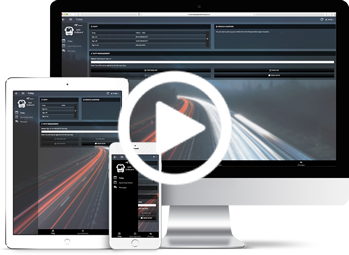8 Steps to a brighter future for passenger information
With demand for passenger information ever increasing among the travelling public, it is crucial that providers of public transport are able to offer their customers effective, reliable and accurate information across a range of platforms. Yet with budgets ever decreasing in this age of austerity, the challenge here is to do so cost effectively. However, this needn’t seem daunting. In fact, we believe there is a brighter future ahead for passenger information systems – and the companies that use them. The following steps show how you could get there…
1. Identify a clear passenger information strategy
A critical step in ensuring the effective delivery of passenger information is to first establish a clear strategy for your organisation. This strategy will be unique to you, varying from organisation to organisation. Yet in developing your strategy, there are a number of broad factors here that will likely influence decision making.
These factors include identifying your target audience (for example, the travelling public or third party organisations); as well as deciding upon a budget that works for your organisation.
A clear strategy with business aims and objectives can greatly increase your ability to achieve your end goal.
2. Remember who your passengers are: different people have different requirements
There is no such thing as a ‘typical traveller’ who you can tailor your passenger information for. As a result, each of your passengers will have different information requirements of your organisation.
While there may be no such thing as an average traveller, there are clearly identifiable ‘types’ of bus users, who we can – to an extent – generalise about. For example, inexperienced travellers will likely make greater use of pre-planning systems and journey planning tools; while experienced and confident commuters will likely have more intensive information requirements. Indeed, this latter group may expect information on disruptions and delays to be pushed out to them during their journey – keeping them in the loop in real-time.
By gaining a comprehensive understanding of who your passengers are and their information requirements, we are more able to tailor our information solutions and services to the needs of passengers effectively. So this means passengers are able to access the information that works for them!
When passengers have this choice, they are more likely to utilise your systems and services, and may also be more willing to sign up to your services – providing you with valuable passenger data.
3. Consider the mobile!
There has been a clear and inexorable rise of ‘mobile’ over ‘desktop’ browsers in recent years. Because of this trend, it is perhaps clearer than ever before that, when it comes to passenger information, the emphasis will increasingly be on developing, using and delivering more intuitive user interfaces, built on Responsive Web design principles, so that users of any device have the same experience.
With predicted smartphone penetration reaching over 90% by 2017, it is absolutely critical that you take this trend into account when building your passenger information solutions and services of the future. Long gone are the days where we could simply add ever more functionality to traditional desktop sites: the future is the mobile.
Because of this, we feel it is important to understand the competing benefits and drawbacks of both responsive mobile websites and smartphone apps. It is likely both will form crucial parts of any future passenger information industry – but deciding which is right for your organisation and your budget is a crucial step in delivering a passenger information solution that works for you.
4. Embrace the potential of journey planning
Journey planning solutions have unquestionably come a long way in the past 20 years, yet in many ways they remain limited, as they often don’t look beyond the assumption that users want to plan a journey either using their private care, or with public transport solutions. Surely, in this day and age, the most useful solution for many travellers would be a journey planning solution that caters for travel by both car and public transport?
This theory underlined the successful development of ChoiceRail, which embraces the concept of mixed mode journey planning.
With the prototype ChoiceRail mixed mode planner paving the way, the stage is set for the development of new journey planning systems that utilise effective user interfaces that overcome the issue of travellers needing to juggle several different road and public transport planners on their desktop screens (such actions are near impossible on a smartphone screen). In this way, these systems will also help encourage people out of their cars and onto public transport for significant parts of their journeys.
5. Interactive information
Printed publicity – for so long the corner stone of passenger information in the public transport industry – is changing. Indeed, it is increasingly looking to incorporate interactive elements. Near Field Communication (NFC) and Quick Response (QR) codes are becoming ever more common at bus stops and stations, and these tools enable printed materials to be enhanced with specific information – while also enabling traditional blended schedule data to be blended with real-time elements.
Reports of the death of printed publicity have been greatly exaggerated – to paraphrase Mark Twain. Yet if you are to build and deliver the successful and cost-effective passenger information solutions and systems of the future for your passengers, it is critical that you utilise tools that enable you to create modern, interactive printed materials; but at a lower cost than previously.
Tools like Novus-Publish can be used here to help you take the steps toward building passenger information solutions of the future. Automation tools like this can take service changes and identify output changes; then batch print them ready for installation at whichever stops need updating. This simplifies processes and workflows, while also utilising customisable templates that ensure consistency with your organisation’s branding, while also enabling interactivity by including specific objects, such as QR codes.
While it is clear the general trend is toward mobile information and responding to the growing smartphone market; there remain significant numbers of passengers who rely on printed material to help them get from A to B. For this reason, any future public information system must – strange though it perhaps may sound – continue to use traditional information. It just needs to be modernised!
6. Enable integration
By utilising a passenger information system that can bring together real-time data from multiple sources – such as AVL data from a buses’ ETM, or scheduling data from a Local Authorities’ back office – it is possible to deliver passengers a fully integrated and information rich experience, while also improving data quality.
This is something that a number of Local Authorities and commercial bus operators are already doing. For example, in Wiltshire, teams from the local council are “linking with the AVL units and ticketing machines on most local bus operator vehicles in order to provide really accurate real-time information,” according to Elizabeth Douglas – Wiltshire’s Real-Time Bus Information Systems Manager.
But of course there’s further value of using systems that enable this sort of integration – not only can they enhance data quality (and thus improve passenger experience); they can also improve joined-up working with your partner organisations – be they Local Authorities, Commercial Bus Operators, or third-party organisations.
7. The personal touch
Just as the increasing use of smartphones by passengers is an important trend to consider when it comes to the future of passenger information, so too is the rise of social media – and its utilisation as a means of pushing out travel information to the travelling public.
It certainly appears as though social media tools like Twitter can be used to great effect by transport providers. Just look to Travel South Yorkshire, for an example of an organisation building good rapport with passengers on Twitter (see @TSYalerts).
While it is important to recognise the benefits of social media to your passenger information strategy, it is also important to understand that social media is just one part of providing users with a genuinely personal, tailored information solution.
A useful step for organisations to take is to invest in tools that enhance the personalised messaging aspect of social media messaging – and take it further. With products like Trapeze’s Situation Console, it is possible to enable passengers to receive specific information concerning their unique travel route – such as incidents or any disruptions or delays. In other words; passengers only see what they need to see.
8. What’s in a name? Building trust in your brand
When it comes to passenger information, it really is a matter of trust. Members of the public are most likely to turn to brands they trust when looking to acquire the information they need to make their journeys. Because of this, it is vital to ensure your brand is thought of as trustworthy by your passengers. And to do this, your passenger information needs to be consistently accurate and reliable.
Of course, if you’ve followed the previous steps outlined in this article, you’ll be well on your way to providing your passengers with the highest quality information – and in a way that suits their individual needs as public transport users. So the next stage is to ensure your passenger information tools are firmly associated and linked with your organisation’s brand and message.
By using tools that can be tailored to your requirements and designed to fit your style and brand, you are able to do just this. By providing your own sites, you can further help maintain the trusting relationship with your passengers, control the quality of information they receive, and ensure it is your message they receive when looking for travel information.
These tools thus improve your brand strength, while simultaneously improving quality of passenger information – so that both your organisation and your passengers receive reciprocal benefits!
Conclusion
To take the right steps on the path to a brighter future for passenger information, then, technology will help Local Authorities and Bus Operators alike in revolutionising the way we deliver travel information to our passengers.
By following the above steps, the future really could be a bright one.
Sorry, did we say the future? All of this is possible right now!

Here to help
Contact us and speak with one of our specialists:
+44 (0) 808 281 1039
More Info
About Us | Careers | Contact Us | Legal | Privacy
(c) 1999 – 2019 Trapeze Software ULC. All rights reserved
Trapeze Group respects your privacy

